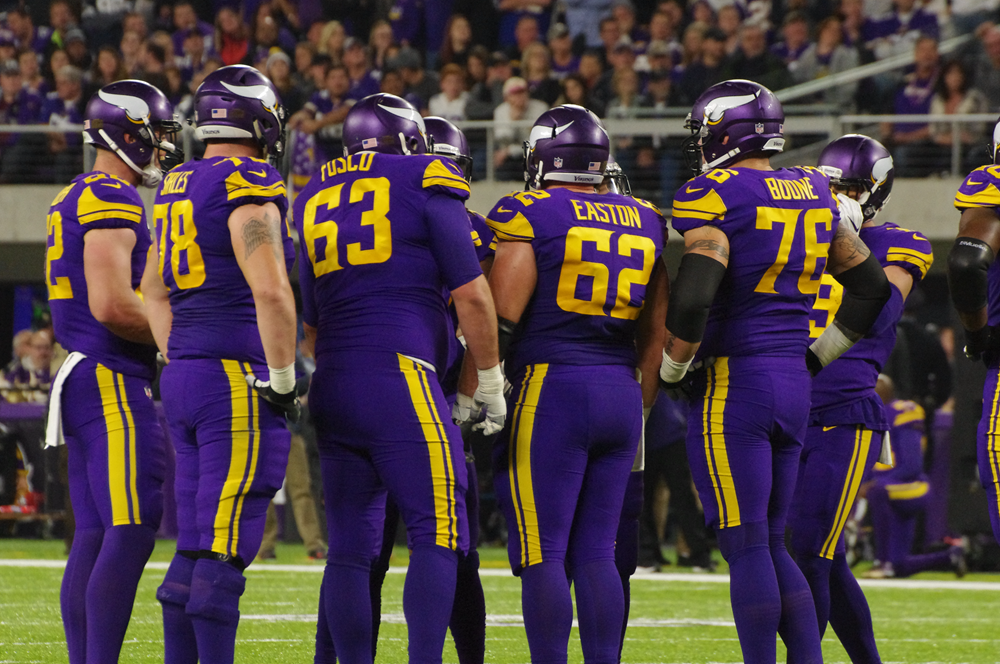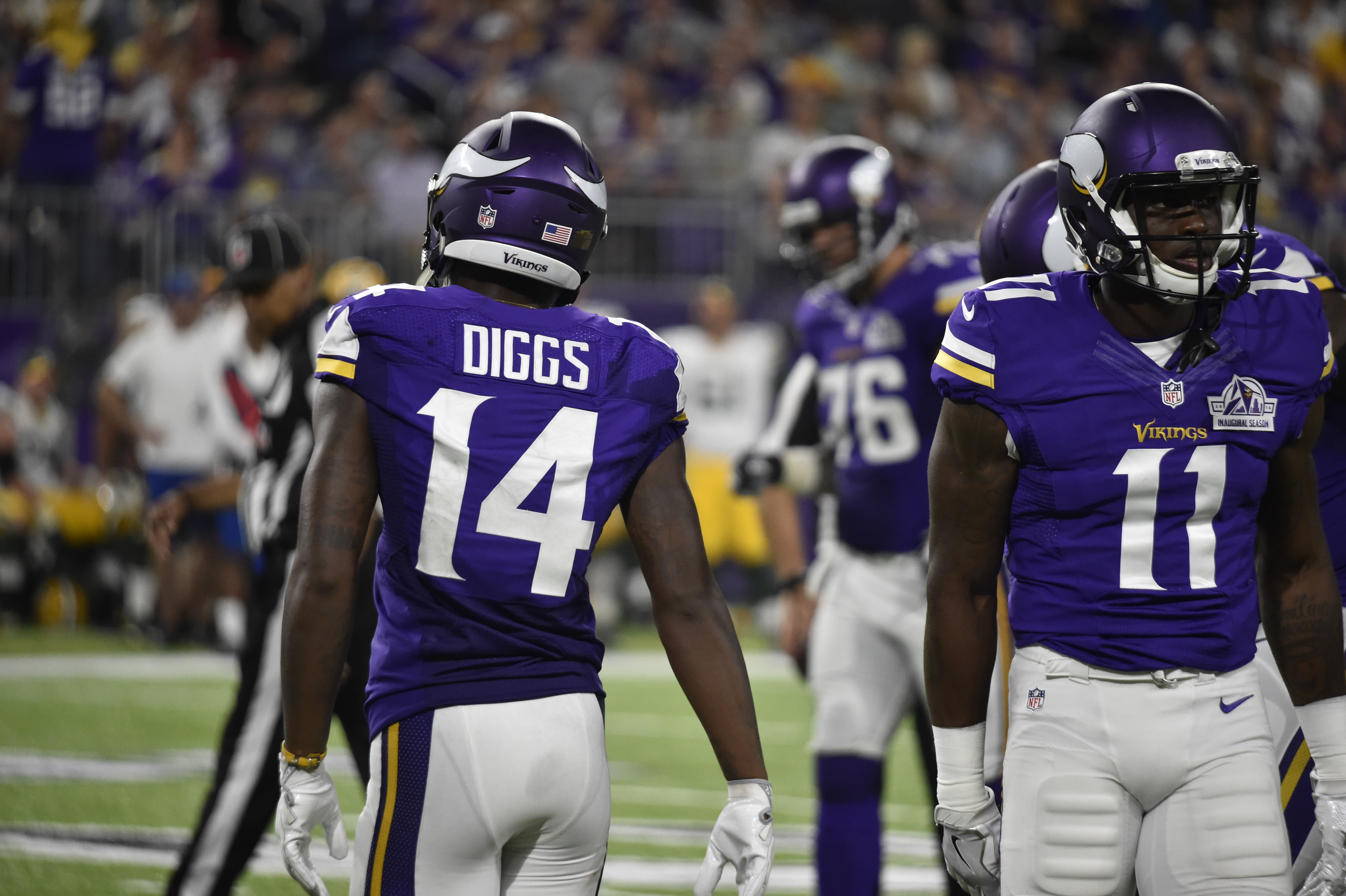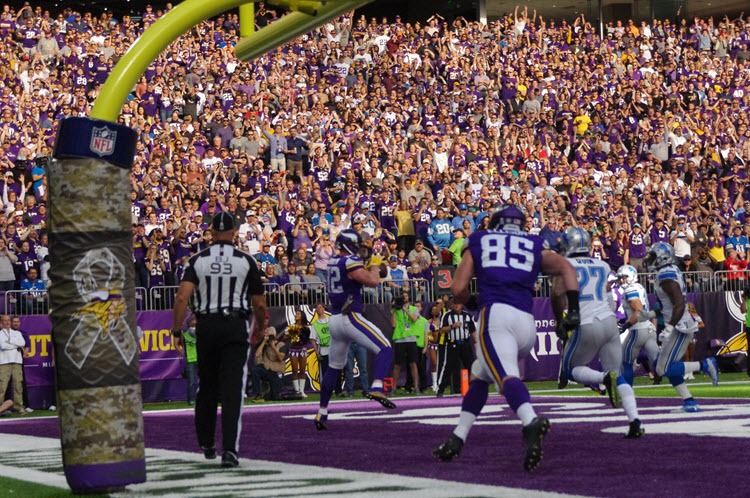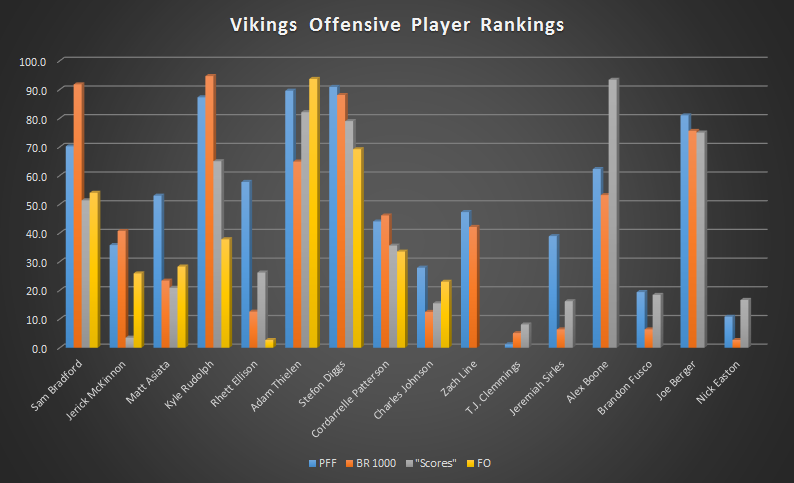Written By Arif Hasan (ColdOmaha.com)
Photo Credit: Kyle Hansen, Brian Curski
After a disappointing season, the Minnesota Vikings offense clearly needs help. It may benefit the team that Pat Shurmur is the now-permanent offensive coordinator, and offensive line investments should provide significant assistance—but finding extra efficiencies elsewhere could mean the difference between a playoff berth and sitting at home for one more year. After all, if the Vikings had closed out their first game against the Detroit Lions, they might still be in contention for a Super Bowl bid.
One approach is to see how various approaches to grading judge the players on the Vikings offense. Given that we also have a feel for how those players did, this is a good opportunity to grade the graders and check out what the differences are between high-profile grading systems like Pro Football Focus’, Football Outsiders’ and Bleacher Report’s Top 1000 project.
Along with those three systems, we’ll compare player performance to simple “scores” I’ve developed for each position using advanced statistics. For clarity’s sake, because PFF provides both advanced statistics and subjective grades, the “PFF” evaluation will be their grades, while some of their advanced statistics will be used in the “scores” evaluation.
For quarterbacks, it’s total adjusted yards per play—essentially accounting not just for passing touchdowns, interceptions, passing yards and sacks, but also fumbles, rushing yards and rushing touchdowns. The statistic is explained here.
With offensive linemen, the statistic I chose to use was Pro Football Focus’ pass-blocking efficiency, which is essentially a measure that looks at how many pressures a lineman gives up, with a little more weight given to sacks over hits and hurries. It doesn’t account for run-blocking, and that serves as a major weakness of the measure, but it gives us a decent look at one critical aspect of performance.
For tight ends and wide receivers, the measure I’m looking at is yards per route run, which is a simple but effective measure of receiver production that accounts for playing time; receivers rarely play 100 percent of their team snaps, and different teams pass or run in different proportions. By taking total yards and dividing by their opportunities to earn those yards.
Finally, running back scores were created using two statistical measures: success rate (how often their runs constituted a success based on down and distance) and yards over expectation—how many yards each running back earned over the average running back in the same down and distances.
Because each organization will have a different number of qualifying players (for example, Pro Football Focus has 36 qualifying quarterbacks while Football Outsiders has 34), we’ll use percentile to get a better gauge of where players are ranked; if a player is in the 90th percentile of a particular metric, that means his score is better than 90 percent of the players at his position.
| Player | Position | PFF | BR 1000 | FO | “Scores” | Overall |
| Sam Bradford | QB | 70.2 | 91.8 | 54.0 | 51.4 | 66.9 |
| Jerick McKinnon | RB | 35.8 | 40.7 | 25.9 | 3.5 | 26.5 |
| Matt Asiata | RB | 53.0 | 23.4 | 28.3 | 20.9 | 31.4 |
| Zach Line | FB | 47.3 | 42.1 | 27.4 | N/A | 44.7 |
| T.J. Clemmings | OT | 1.2 | 5.1 | 8.1 | 4.8 | |
| Jeremiah Sirles | OT | 38.9 | 6.4 | 16.2 | 20.5 | |
| Alex Boone | OG | 62.3 | 53.2 | 93.4 | 69.6 | |
| Brandon Fusco | OG | 19.4 | 6.4 | 18.4 | 14.7 | |
| Joe Berger | OC | 81.0 | 75.6 | 75.0 | 77.2 | |
| Nick Easton | OC | 10.8 | 2.7 | 16.7 | 10.1 | |
| Kyle Rudolph | TE | 87.3 | 94.7 | 37.8 | 65.0 | 71.2 |
| Rhett Ellison | TE | 57.8 | 12.6 | 2.7 | 26.2 | 24.8 |
| Adam Thielen | WR | 89.6 | 64.9 | 93.7 | 82.1 | 82.6 |
| Stefon Diggs | WR | 90.9 | 88.1 | 69.2 | 79.0 | 81.8 |
| Cordarrelle Patterson | WR | 44.0 | 46.1 | 33.5 | 35.6 | 39.8 |
| Charles Johnson | WR | 27.9 | 12.5 | 23.0 | 15.5 | 19.7 |
So, here we see that Sam Bradford was graded very highly by Bleacher Report and middling by the two statistical measures: Football Outsiders’ DVOA and total adjusted yards per play.
Pro Football Focus saw him as generally above average.
The different approaches really highlight how they end up evaluating players. Pro Football Focus and Bleacher Report have fundamentally film-oriented evaluations but differ in methodology. Bleacher Report breaks down technique and uses traditional scouting tools, while PFF doesn’t care about technique or traditional scouting—they look to see if a player accomplished their goal.
If a receiver runs a shoddy route but catches the ball, PFF may give that player a positive grade on that play while Bleacher Report may not.
Football Outsiders, meanwhile, evaluates a proprietary statistical output for players involved in a play, then adjusts those statistics for opponent.
This could explain why Adam Thielen is highly regarded by Pro Football Focus and Football Outsiders—good production and performance in a low-volume offense—while Bleacher Report may have found his technical work a little wanting.
Because Football Outsiders and the statistical scoring system don’t take into account blocking ability, the biggest differences in rankings comes for the tight ends; Kyle Rudolph and Rhett Ellison both suffer in Football Outsiders’ DVOA measure, but Rudolph did very well in Bleacher Report and PFF’s more holistic grading systems.
This seems to imply that Rudolph, a receiving tight end, was a fine blocker when asked, and probably deserves more credit for his receiving than basic receiving statistics would indicate—perhaps by extending his catch radius to corral tough throws or winning contested catches.
Ellison was not well-liked by statistical measures, though PFF decided he was largely average overall—likely because of his blocking (PFF put him in the 70th percentile as a blocker). Interestingly, the other group that takes into account blocking (Bleacher Report) thought even worse of Ellison than the receiving metrics; Bleacher Report graded him in the 45th percentile in blocking among tight ends.
It might be that PFF found him to be effective in executing his assignments while the grader for Bleacher Report didn’t think his technique was on-point.
For the offense, the measures disagreed the most when evaluating tight ends. After that, they diverged with Alex Boone (extremely well-regarded statistically, fairly average by Bleacher Report) the most, followed by Sam Bradford—who is a top five quarterback by BR standards and a slightly above-average quarterback in both total adjusted yards per play and Football Outsiders.
Pro Football Focus split the difference between the statistical measures and Bleacher Report for both Bradford and Boone.
Everyone seemingly agreed on two offensive linemen, however. T.J. Clemmings was in the single percentiles among tackles, while Joe Berger was fairly good against other centers.
After that, Brandon Fusco and Nick Easton drew fairly even placements in the bottom 15 percent of their positions and there was a somewhat wide gap in evaluation of Jeremiah Sirles—with Pro Football Focus giving him a grade near the 40th percentile and Bleacher Report in the sixth percentile. As a pass protector, he was statistically in between the two.

Even crazier is the fact that some offensive linemen have worse scouting grades than their pass-blocking efficiency scores; bottom-level performance from T.J. Clemmings, Nick Easton and Brandon Fusco was further downgraded by PFF or Bleacher Report. There are likely two reasons for this: run-blocking, which of course is likely the biggest contributor, and ease-of-assignment.
Vikings fans have been calling for a reduction of seven-step drops since Teddy Bridgewater finished his rookie year strong after a switch to a quick-strike offense late in the season. When that didn’t materialize in 2015 and he was the most pressured quarterback in the NFL, calls for easier blocking renewed—and former offensive coordinator Norv Turner followed through.
At the beginning of 2016, the Vikings had more 3-step and 5-step drops in his games than they ever did in his first two seasons as a coordinator, and the ball came out even quicker after the switch to Shurmur partway through the season.
This lightened the load and reduced the number of pressures without commensurately increasing the actual talent of the offensive linemen.
In the same way that a receiver with a good quarterback will get boosted yards per route run or per target numbers, an offensive lineman with a fast offense will benefit from improved pass protection numbers. Evaluation from film that PFF and BR engage in should account for this in different ways.
There’s also the possibility that some of the Bleacher Report grades are influenced by reputation; Bradford established himself within the Vikings system early and his late-season struggles may have been glossed over, while Adam Thielen—a tryout undrafted free agent—didn’t earn much accolades for years before breaking out and becoming the first 1000-yard receiver for the Vikings since Sidney Rice.
That’s not the entire difference, but it’s worth considering. It also seems necessary to point out that Bleacher Report may not be weighting grades across season correctly, though that’s just supposition. If Thielen played a few snaps in early games and more snaps in later games, those early games may have had too much weight relative to how much he actually played.
Regardless, even with that discrepancy, Adam Thielen and Stefon Diggs gave the Vikings one of the only two receiver pairs to both rank in the top fifteen among peers (along with Dallas’ Cole Beasley and Dez Bryant). Thielen is the second-highest ranked “second receiver” using the average of the three methods, just behind Cole Beasley.
Alongside generally well-graded receivers Adam Thielen and Stefon Diggs are Cordarrelle Patterson, where a 40th-percentile showing is significantly better than where he was in previous years.
Patterson isn’t particularly high among third receivers (he ranks 20th among receivers who are third on their team) but with the development of Laquon Treadwell or the addition of another receiver, would be one of the strongest fourth receivers.

Between the two running backs, Matt Asiata (3.3 yards per carry) was more consistent than Jerick McKinnon (3.4 YPC) and therefore earned more praise from Pro Football Focus and the statistical measures that emphasized success rate.
Bleacher Report liked McKinnon’s versatility—as a receiver and outside runner, he graded higher than Asiata, despite Asiata getting more receiving yards on fewer receptions. Something BR might emphasize are McKinnon’s more difficult receiving assignments, and Asiata’s relative success in those assignments played a smaller role than it did for PFF.
Zach Line was generally regarded as a slightly below-average fullback by the scouting services, with no statistical contributions bringing him up or down relative to other fullbacks.
Generally speaking, there were five players that were universally regarded as above-average: Joe Berger, Alex Boone, Stefon Diggs, Adam Thielen and Sam Bradford. In addition, Kyle Rudolph only received one below-average mark and it was the one perhaps most blind to his overall contributions (yards per route run).
What this also tells us is that when using one of various measures to evaluate a player or make an argument for them, it’s important to keep in mind context—context such as methodology, the goals of the evaluation and any potential biases that may enter the conversation.
A quarterback with poor mechanics and risky decision-making may end up being fairly good overall but might be dinged by a technique-oriented evaluation like in Bleacher Report’s method until they catch up to how successful he can be.
On the other hand, Pro Football Focus’ approach of evaluating outcomes may not account for sustainability—bad form can often lead to exploitable error. A one-read quarterback with a novel offense might get good PFF grades but could be taken apart by able defensive coordinators in the following season.
Still, all of this concretizes what we know about the offense in general; the offensive line is a significant problem, the receivers are surprisingly high-quality, and though opinions are split on Sam Bradford, he has been operating like an above-average quarterback at worst.
Their running game was in shambles, and it seems like the explosive traits of Jerick McKinnon were favored by those “scouting” running backs over the consistency (which took a big dip this year) of Matt Asiata, preferred by the results-oriented Pro Football Focus. Either way, if the running back grades are independent of their blocking, it’s another area worth investing in.
There are some more details to be found from this analysis; Jeremiah Sirles isn’t all that bad by at least one measure and if that bears out (and perhaps he moves to right guard), it could lighten the load for what will be a crucial offseason for the Vikings—but for the most part this gives us a decent analysis of where the Vikings’ crucial weak points are.
Next, we’ll look at the defense.










